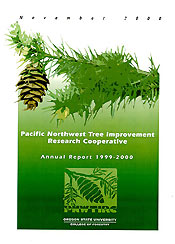Annual Report 1999-00
Highlights of 1999-2000
- Tom Adams resigned from the PNWTIRC's leadership to become Head of the Forest Science Department at Oregon State University.
- Families varied considerably in their response to summer drought applied in the nursery in terms of growth, growth increment, xylem cavitation, hydraulic conductivity, and shoot damage. Genetic correlations between drought hardiness traits in the same year were high, and were low to moderate between different years. Seedling growth potential of families under well-watered conditions is uncorrelated with drought hardiness, suggesting that selection for growth traits will not reduce drought hardiness of the selected trees. Moderate drought applied to seedlings during the second growing season greatly reduced their growth increment in the following recovery year.
- Due to their low heritability and difficulty of measurement, there seems to be little practical utility to using drought sensitivity coefficients (DRCs) to assess drought hardiness in older, field-grown trees. The lack of correlation between DBH and DRCs is encouraging because like in seedlings, it suggests that selection for rapid stem growth in older trees will not inadvertently reduce hardiness to summer drought. The relationship between drought hardiness in seedlings and the ability to grow under summer moisture deficits later in the rotation is unclear.
- Additional analysis of data from the Cooperative's Early Testing Study showed unfavorable correlations between growth potential and stem form and branching traits in seedlings, such that selection for growth alone is expected to increase the number of whorls with steep-angle branches and stem sinuosity in older trees. To avoid negative impacts, appropriate stem form and branching traits should be included with growth traits in nursery-stage selection. Alternatively, growth potential could be emphasized in initial nursery culling, with stem form and branching traits dealt with later in field selections.
- Microsatellite and minisatellite DNA markers are highly polymorphic. These markers should be very effective for mating studies, including pollen contamination analysis. Four to six microsatellite marker loci should be sufficient for pollen contamination estimation in Douglas-fir seed-orchards.
- A site for the Miniaturized Seed Orchard Study was selected and prepared for planting of rootstocks in winter 2001. An advisory committee of seed orchard managers and other experts was formed to guide the implementation of the study.


